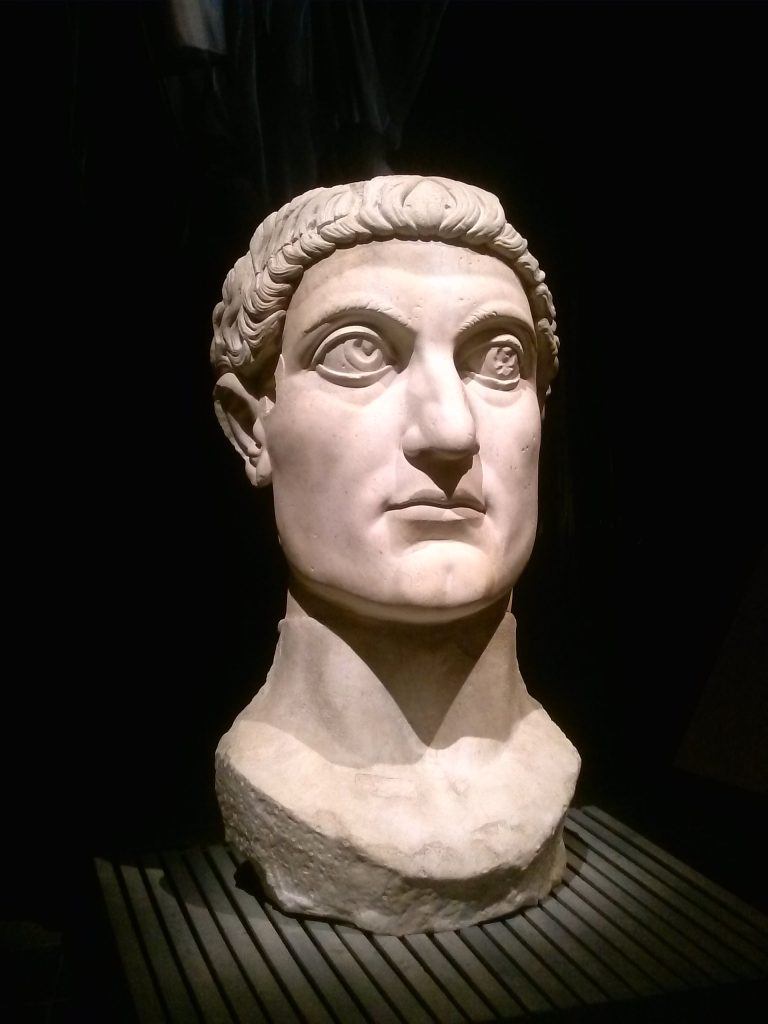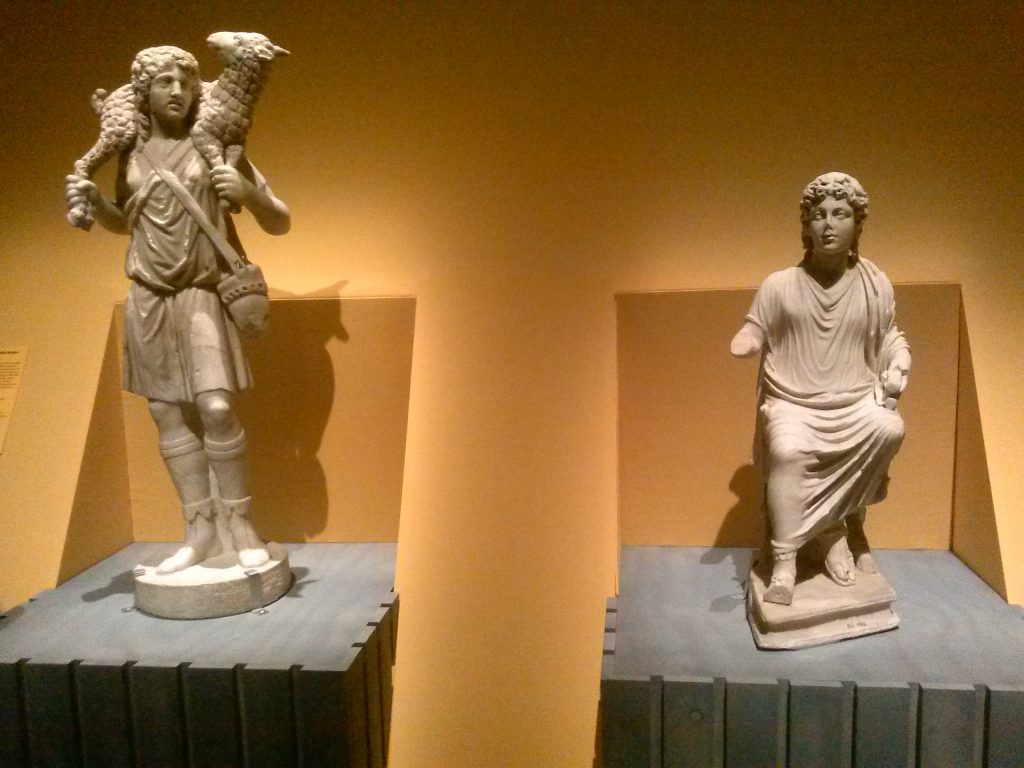De man met de ferme kaken en lege, omhoogkijkende ogen is niet echt aantrekkelijk. Zijn gezicht prijkt wel op alle affiches in de stad. Het is echter iets anders dan deze robuuste stenen kop tegen de zwarte achtergrond dat je triggert, op het affiche van de tentoonstelling in de Nieuwe Kerk in Amsterdam. Dat is de gekantelde O van het woord Rome. ‘’Rome. De droom van keizer Constantijn’’ heet de expositie. En die scheve letter symboliseert het kantelpunt in de geschiedenis, waarover deze tentoonstelling gaat.

Hier in de Nieuwe Kerk wordt het verhaal verteld van Keizer Constantijn, die in de vierde eeuw het Christendom alle de ruimte gaf. De keizerlijke hoofdstad vol tempels van Romeinse goden wordt dankzij hem het pauselijk centrum van de wereld. Er worden kerken gebouwd en de christenen krijgen de gelegenheid openlijk hun geloof te belijden. Het verhaal van deze wending wordt verteld aan de hand van tientallen oud-Romeinse en vroeg-christelijke schatten, die nog nooit eerder te zien waren in Nederland.
Triomfboog
De expositie voelt als een wandeling door oud-Rome.Want het is alsof je Rome binnenstapt en daar een toneelstuk in vijf bedrijven beleeft. Je loopt onder een triomfboog door en het eerste wat je ziet (of denkt te zien) is een enorm beeld van keizer Constantijn. Zo imposant (want twaalf meter hoog) moet zijn beeld er althans ooit uit hebben gezien. Wat er nog van over is, een hoofd, een voet en een hand, staat in Rome. In de Nieuwe Kerk is nu een kopie te zien. Deze kop is de helft van de ware grootte. Hier, in deel 1 van de tentoonstelling, neemt Rosita Steenbeek, onze Nederlandse vrouw in Rome, je als een stadsgids bij de hand. Het lijkt in deze vroege vierde eeuw een tolerante, multireligieuze samenleving, maar het christendom wordt nog niet geaccepteerd. Het is de keizer die aanbeden wordt en die geen concurrentie duldt.
Onbekende vrouw
 In de audiotour legt Rosita Steenbeek op prettige toon uit wat de hier tentoon gestelde sarcofagen, mozaïeken en een marmeren buste van een ‘’onbekende vrouw’’ uitbeelden. Gastconservator Eric Moorman (hoogleraar Klassieke Archeologie in Nijmegen) wijst erop wat een prachtstuk hier naartoe is gehaald: deze onbekende vrouw is een beeld uit één stuk, maar het hoofd is van wit marmer, terwijl in haar kleding je juist de aderen van het marmer ziet, alsof dat gebruikt is al dessin van de blouse. De tweede gastconservator, hoogleraar Vroegchristelijke Kunst en Architectuur Sible de Blaauw (eveneens van de Radboud Universiteit), vindt het juist weer prachtig op deze tentoonstelling – voor het eerst! – twee beelden naast elkaar te zien, die in Rome in twee verschillende musea staan. Het hoogtepunt van de tentoonstelling zijn voor hem dat ‘’Beeld van een schaapdrager/de Goede herder’’ en ‘’Beeld van een leraar/Lerende Christus’’ – hier naast elkaar staan. Het zijn voor hem twee van de meest iconische voorstellingen van Christus. Beelden die oorspronkelijk wellicht iets anders voorstelden, maar Christus als herder en als leraar zijn later typisch christelijk geworden.
In de audiotour legt Rosita Steenbeek op prettige toon uit wat de hier tentoon gestelde sarcofagen, mozaïeken en een marmeren buste van een ‘’onbekende vrouw’’ uitbeelden. Gastconservator Eric Moorman (hoogleraar Klassieke Archeologie in Nijmegen) wijst erop wat een prachtstuk hier naartoe is gehaald: deze onbekende vrouw is een beeld uit één stuk, maar het hoofd is van wit marmer, terwijl in haar kleding je juist de aderen van het marmer ziet, alsof dat gebruikt is al dessin van de blouse. De tweede gastconservator, hoogleraar Vroegchristelijke Kunst en Architectuur Sible de Blaauw (eveneens van de Radboud Universiteit), vindt het juist weer prachtig op deze tentoonstelling – voor het eerst! – twee beelden naast elkaar te zien, die in Rome in twee verschillende musea staan. Het hoogtepunt van de tentoonstelling zijn voor hem dat ‘’Beeld van een schaapdrager/de Goede herder’’ en ‘’Beeld van een leraar/Lerende Christus’’ – hier naast elkaar staan. Het zijn voor hem twee van de meest iconische voorstellingen van Christus. Beelden die oorspronkelijk wellicht iets anders voorstelden, maar Christus als herder en als leraar zijn later typisch christelijk geworden.

Catacomben
In deel twee van de expositie neemt stadsgids nummer 2, Rome-kenner Antoine Bodar, ons mee door de catacomben van Rome. Want het christendom leeft begin vierde eeuw nog ondergronds. De Romeinse goden van weleer boeten al in aan populariteit: op de sarcofagen staan traditionele thema’s en Christelijke scènes al naast elkaar. Het kruis als teken van overwinning komt dan ook voor het eerst in beeld.
Visioen
Dat kruis waaraan Jezus Christus is gestorven heeft een belangrijke rol gespeeld in de omwenteling die in de vierde eeuw plaats vond. Keizer Constantijn had namelijk een droom. Een visioen. Daarin zag hij een lichtend kruis en hem werd verzekerd dat hij Gods steun zou krijgen bij de veldslag. En Keizer Constantijn versloeg vervolgens inderdaad zijn rivaal Maxentius bij de Slag bij de Milvische Brug in 312.
Dat was voor Constantijn reden om vrijheid van godsdienst in te voeren en openlijk aanhanger van het christendom te zijn. Hij laat dan direct monumentale kerken bouwen. Dit verhaal wordt uitgebeeld in zaal 3, waar enorme kopieën van fresco’s uit het Vaticaans Museum hangen. Het visioen, de veldslag en de triomf van het Christendom zijn op grote doeken weergegeven. En hier ligt bovendien een kostbaar camee, het grootste uit de klassieke oudheid. Het verhaal van de triomf van keizer Constantijn is bewerkt in agaat.
In de laatste ruimte van de tentoonstelling lopen deel 4 en 5 in elkaar over. In deel 4 vertelt Sible de Blaauw hoe de kerk aan invloed wint in Rome en hoe Rome de hoofdstad van de wereld wordt. De kerken worden dankzij Constantijn rijkelijk ingericht en deze kerken uit de late oudheid zijn nog altijd markante gebouwen in Rome.
De tentoonstelling sluit af met schilderijen die het vroege christendom uitbeelden. Stadsgids Nelleke van der Krogt, de laatste Rome-kenner, vertelt over het prachtige schilderij van Il Veronesi, ‘’Het visioen van de Heilige Helena’’. Hij heeft de moeder van keizer Constantijn geschilderd, die ook een visioen met een kruis krijgt.
Stevige hand

De enorme hand van Constantijn, die met zijn vinger omhoog wijst, vormt het einde van de tentoonstelling. Dat beeld kan allerlei dingen symboliseren, zo valt op te maken uit wat de stadsgidsen er ter afsluiting over zeggen. Volgens Rosita Steenbeek zie je hierin de stevige hand die Constantijn had in het Christendom. Voor Eric Moorman symboliseert hij de pretenties en de wereldveranderingen. Hij veranderde de kijk van de wereld op Rome, dat vanaf dan een christelijke stad wordt. De hand symboliseert de wereldlijke macht, terwijl hij ook naar de hemel wijst. Sible de Blaauw ziet hoe Constantijn de hand had in de schepping van Europa. Nelleke de Krogt ziet het als de grote invloed op de westerse cultuur. En Antoine Bodar voegt er nog iets aan toe, wat ons weer naar onze eigen tijd brengt: ’’Het Christendom werd bevorderd in de tijd van Constantijn. En nu zijn we aangekomen in 2015, in de Lage Landen. Hier zijn we in een kerk, die ontruimd is om een tentoonstelling te organiseren.’’
Rome. De droom van keizer Constantijn’’ in de Nieuwe Kerk, Amsterdam. Van 3 oktober tot 7 februari 2016. Meer info: www.nieuwekerk.nl
Bij de expositie verschijnt de gelijknamige catalogus, geschreven door Eric Moorman en Sible de Blaauw. Prijs € 19,95. Rosita Steenbeek schreef speciaal voor de tentoonstelling haar eerste kinderboek: ‘’De triomfboog’’. Prijs € 12,95.
